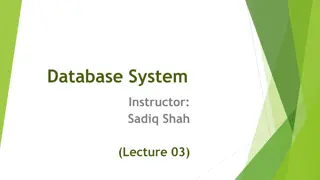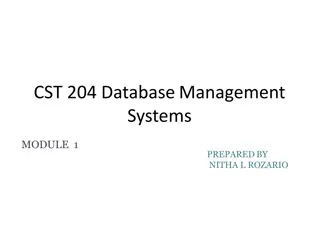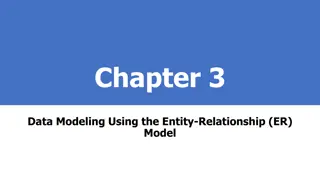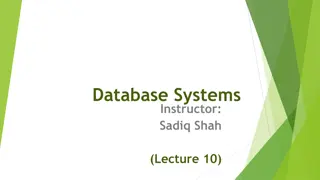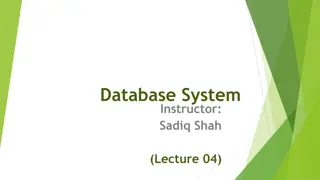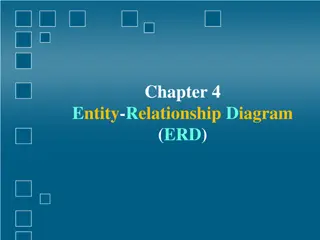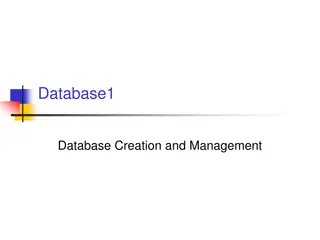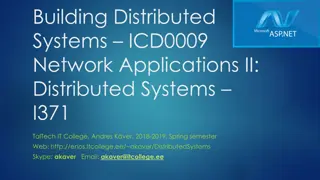Understanding Entity Framework in C# for Database Management
Entity Framework in C# offers a powerful ORM solution for data manipulation and database management. It allows developers to work with databases in an object-oriented manner, simplifying the handling of database operations. Learn about ORM, Code First approach, conventions, DbContext usage, and database initialization processes in C# Entity Framework.
Download Presentation

Please find below an Image/Link to download the presentation.
The content on the website is provided AS IS for your information and personal use only. It may not be sold, licensed, or shared on other websites without obtaining consent from the author. Download presentation by click this link. If you encounter any issues during the download, it is possible that the publisher has removed the file from their server.
E N D
Presentation Transcript
C# - Entity Framework IT COLLEGE 2016, ANDRES K VER HTTP://ENOS.ITCOLLEGE.EE/~AKAVER/CSHARP
C# - ORM 2 ORM Object Relational Mapping For converting data between incompatible type systems in oop languages. In effect creates virtual object database , for using within the oop language .NET ORM systems Entity Framework Microsoft NHibernate Dapper and many others
C# - EF 3 Model, databse or code first?
C# - EF, Code First 4 Code First approach Write your business classes Add relationships between classes Add attributes Add custom getters and setters where needed EF will construct database based on your classes EF will handle all the CRUD, converting code into sql clauses
C# - EF conventions 5 Every entity (class) has to contain attribute suitable for primary key (PK) Attribute with name Id or <EntityName>Id is automatically taken as PK Other conventions set string length, structure of tables in case of inheritance, cascade delete, etc Every convention in EF can be configured or changed You can add your own conventions
C# - EF and DbContext 6 Entities have no idea of EF To use EF you need to add class, that inherits from DbContext Inside DbContext, add neccesary DbSet<Entity> attributes Relational tables are created automatically DbContext database, DbSet table in database
C# - EF, DbContext 7 public class ContactContext : DbContext { public DbSet<Person> People { get; set; } public DbSet<Contact> Contacts { get; set; } public DbSet<ContactType> ContactTypes { get; set; } }
C# - EF, DB initialization 8 EF will create your DB on first access Afterwards, when you change your domain classes exception: The model backing the 'ContactContext' context has changed since the database was created. Consider using Code First Migrations to update the database (http://go.microsoft.com/fwlink/?LinkId=238269). EF will create in memory model of your Db structure and save its hash into db. During next db initialization hashes are compared if they are not matching db is changed from outside. Solution migrations (data is retained) or recreation (data is lost) of db.
C# - EF, Db initialization 9 Different strategies exist CreateDatabaseIfNotExists default DropCreateDatabaseIfModelChanges DropCreateDatabaseAlways MigrateDatabaseToLatestVersion Or create your own Set DB initializer in your DbContext class constructor Database.SetInitializer<MyDBContext>(new DropCreateDatabaseIfModelChanges <MyDBContext>());
C# - EF, annotations, Fluent API 10 Annotations are the simplest way to configure your entities for EF Several frameworks use the same annotations (MVC, Web Api, EF) Annotations don t cover all options Fluent API is capable of full EF configuration. But only EF sees those configurations. It is necessary to use both options. using System.ComponentModel.DataAnnotations; ... public class ContactType { ... [Required] [MaxLength(128)] public String Name { get; set; } ... } ... public class ContactConfiguration : EntityTypeConfiguration<Contact> { public ContactConfiguration() { Property(t =>t.Value).IsRequired().HasMaxLength(128); } }
C# - EF, Key 11 [Key] Sets, that this attribute is used as primary key in Db Fluent: Entity<T>.HasKey(t=>t.PropertyName)
C# - EF, Required 12 [Required] Attribute value is required, NULL is not allowed in Db Fluent: Entity<T>.Property(t=>t.PropertyName). IsRequired
C# - EF, MaxLength, MinLength 13 [MaxLength(xxx)] Max length of string, db type is nvarchar(xxx) [MinLength(yyy)] String minimum length, used in client side validation (MVC), no Fluent API. Fluent: Entity<T>.Property(t=>t.PropertyName). HasMaxLength(nn)
C# - EF, NotMapped 14 [NotMapped] If attribute is synthetic (calculated) and not stored into Db Fluent: Entity.Ignore(d => d.Property);
C# - EF, ForeignKey 15 [ForeignKey("XxxId")] on object [ForeignKey("XxxName")] on Id Used in case of multiple same type relationships, or if names and keynames of entities don t match Fluent: modelBuilder.Entity<>().HasRequired().WithMany(). HasForeignKey();
C# - EF, Fluent API 16 using System.Data.Entity; using System.Data.Entity.ModelConfiguration; namespace ContactsLibrary { public class PersonConfiguration : EntityTypeConfiguration<Person>{ public PersonConfiguration() { Property(l => l.FirstName).IsRequired().HasMaxLength(150); } } public class ContactContext : DbContext{ public DbSet<Person> People { get; set; } public DbSet<Contact> Contacts { get; set; } public DbSet<ContactType> ContactTypes { get; set; } protected override void OnModelCreating(DbModelBuilder modelBuilder) { modelBuilder.Configurations.Add(new PersonConfiguration()); } } }
C# - Fluent API only configurations 17 Decimal precision (default 18,2) Entity<T>.Property(t=>t.PropertyName). HasPrecision(n,n) Defining relationships Entity.Has[Multiplicity](Property). With[Multiplicity](Property) Has HasOptional, HasRequired, HasMany With WithOptional, WithRequired, WithMany Disabling cascade delete Entity.HasRequired().WithMany(). WillCascadeOnDelete(false) Changing conventions: modelBuilder.Conventions.Remove<PluralizingTableNameConvention>(); modelBuilder.Conventions.Remove<OneToManyCascadeDeleteConvention>(); http://msdn.microsoft.com/en-us/library/gg696316
C# - EF Logging 18 To see, what EF is doing context.Database.Log = Console.Write; Context.Database.Log is an Action<string> so that you can attach any method which has one string parameter and void return type. public class Logger { public static void Log(string message) { Console.WriteLine("EF Message: {0} ", message); } }
C# - EF, Db connection 19 EF system configuration is in startup project config file (app.config) Add connection string <configuration> <configSections> </configSections> <connectionStrings> <add name="DataBaseConnectionStr" connectionString="Data Source=(LocalDb)\MSSQLLocalDB;Initial Catalog=mydbname;Integrated Security=True;MultipleActiveResultSets=true" providerName="System.Data.SqlClient" /> </connectionStrings> Use it in DbContext constructor public class MyDBContext: DbContext { public MyDBContext(): base( name=DataBaseConnectionStr") {
The end 21


